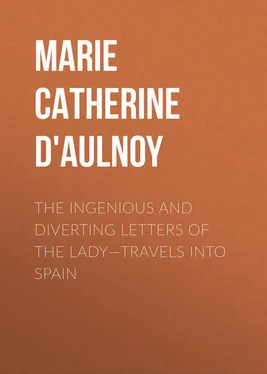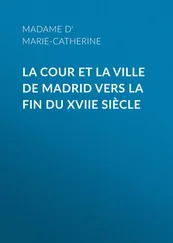Marie Catherine d'Aulnoy - The Ingenious and Diverting Letters of the Lady—Travels into Spain
Здесь есть возможность читать онлайн «Marie Catherine d'Aulnoy - The Ingenious and Diverting Letters of the Lady—Travels into Spain» — ознакомительный отрывок электронной книги совершенно бесплатно, а после прочтения отрывка купить полную версию. В некоторых случаях можно слушать аудио, скачать через торрент в формате fb2 и присутствует краткое содержание. Издательство: Иностранный паблик, Жанр: foreign_antique, foreign_prose, на английском языке. Описание произведения, (предисловие) а так же отзывы посетителей доступны на портале библиотеки ЛибКат.
- Название:The Ingenious and Diverting Letters of the Lady—Travels into Spain
- Автор:
- Издательство:Иностранный паблик
- Жанр:
- Год:неизвестен
- ISBN:нет данных
- Рейтинг книги:3 / 5. Голосов: 1
-
Избранное:Добавить в избранное
- Отзывы:
-
Ваша оценка:
- 60
- 1
- 2
- 3
- 4
- 5
The Ingenious and Diverting Letters of the Lady—Travels into Spain: краткое содержание, описание и аннотация
Предлагаем к чтению аннотацию, описание, краткое содержание или предисловие (зависит от того, что написал сам автор книги «The Ingenious and Diverting Letters of the Lady—Travels into Spain»). Если вы не нашли необходимую информацию о книге — напишите в комментариях, мы постараемся отыскать её.
The Ingenious and Diverting Letters of the Lady—Travels into Spain — читать онлайн ознакомительный отрывок
Ниже представлен текст книги, разбитый по страницам. Система сохранения места последней прочитанной страницы, позволяет с удобством читать онлайн бесплатно книгу «The Ingenious and Diverting Letters of the Lady—Travels into Spain», без необходимости каждый раз заново искать на чём Вы остановились. Поставьте закладку, и сможете в любой момент перейти на страницу, на которой закончили чтение.
Интервал:
Закладка:
The Ingenious and Diverting Letters of the Lady—Travels into Spain Describing the Devotions, Nunneries, Humours, Customs, Laws, Militia, Trade, Diet and Recreations of that People
Madam,
I Humbly beg Leave these Letters may appear in an English Dress, under the Protection of your Name; whose Accuracy in the Original, justly Intitles you to this Dedication; and whose Advantagious Birth, Greatness of Mind, and Uncommon Improvements, exact a Veneration from the most Invidious; and render you an Illustrious Ornament of your Sex.
Madam, For me to attempt here the Publishing your Vertues and Accomplishments, so universally acknowledg’d by all that have the Honour of your Acquaintance, would be to detract from your Merit; and might more justly be censured for Presumption than Flattery.
It were better to imitate the Painter, who perceiving it not possible to represent the Father’s Grief for the loss of his Daughter, drew a Veil over his Face, and owned his Inability.
But I forget, Madam, ’tis my part only to crave your Pardon for this bold Address; and to study ever to approve myself,
Madam, Your most Obedient Servant.IT is not sufficient to write things true, but they must likewise seem probable, to gain belief. This has sometime so prevail’d with me, as to make me think of retrenching from my Relation the strange Stories you will find therein. But I have been withheld from doing this, by Persons of such great Sence and Merit, as has made me conclude, that I cannot do amiss in following their Judgments.
I do not doubt but there will be some, who will accuse me of hyperbolizing, and composing Romances; but such would do well to acquaint themselves first with the Countrey, Humour, and Character of those I treat of. A Fact must not be presently condemn’d as false, because it is not publick, or may not hit every Man’s Fancy. I cite no feigned Names, no Persons whose Death may give me the Liberty of attributing what I please to them.
In a word: I write nothing but what I have seen, or heard from Persons of Unquestionable Credit; And therefore shall conclude with assuring you, That you have here no Novel, or Story, devised at pleasure; but an Exact and most True Account of what I met with in my Travels.
INTRODUCTION
AT the end of the seventeenth century and the beginning of the eighteenth there were several women in France who had gained no small reputation for the writing of amusing if somewhat extravagant Contes des Fées . Of these Marie-Catherine Le Jumel de Barneville, Baroness of Aulnoy, has best survived her contemporaries as the author of La Chatte Blanche , La Grenouïlle Bien-complaisante , Le Prince Lutin , L’Oiseau Bleue , and of other tales which, as M. La Harpe has thought, place her supreme in the realm of delicate frivolity.
The life of this brilliant woman will doubtless present a contrast with most preconceptions of her character based upon a mere reading of her books; and we may be surprised to find in her such a marked individuality, so peculiarly in touch with her time, and offering so little of the ideal and sensitive nature it was fairly natural to infer. We have not, in fact, a mere writer of amusing tales and half romantic histories, but an intriguing, though charming, woman, of a bold and often reckless nature, sufficient to stamp her a worthy daughter of her time. And, after all harsh verdicts have been passed, we shall, I think, return to Madame Aulnoy, by way of her books, with a feeling of affection and interest.
Barneville, near Bourg-Achard (Eure), is her birthplace. Her father was Nicolas-Claude Le Jumel, and her mother, who subsequently married the Marquis of Gudaigne and went with him to Rome, Judith-Angélique Le Coustellier. Nicolas is said to have served long in the armies of Louis XIV., and to have been related to some of the best families of Normandy. Judith later, when in Rome, seems to have rendered peculiar services to the Spanish court, for which she was duly rewarded.
The date of their daughter’s birth is not positively fixed. It is given as 1650 or 1651, but no record of baptism remains, and of the life of Madame Aulnoy previous to the date of her marriage with François de La Motte little is known. That event occurred on Monday, the 8th of March, 1666.
But if the minor details of her life are wanting, we have yet a general and quite sufficient survey of its broader lines. Married at sixteen to a man thirty-six years her senior, we may find in the character of her husband (“un assez triste personage,” as one of his biographers has named him) no uncertain commentary on the subsequent behavior of his wife.
He is described as: “Un bel homme, bien fait, d’abord valet de pied de César, duc de Vendôme, qui cherchait d’avoir de beaux hommes à son service.”
He rose in the confidence of this master, who in 1649 to 1650 employed him in important affairs. This duke of Vendôme, called by Le Vassor 1 1 Histoire de Louis XIII.
“un mince capitaine, que ne sut jamais se faire craindre ni se faire estimer,” had, on his return to France in 1641, been accused of an attempt to poison Richelieu. These were the days of the celebrated Brinvilliers, when Acqua Tofana had been brought from Italy and the number of poisoners was increasing in France. The duke had again returned after the death of Richelieu, and under Mazarin in 1650 was given the government of Bourgogne. In 1653 he took Bordeaux, and two years later put to flight the Spanish fleet before Barcelona. It was in 1653 that La Motte, rising to prosperity with the fortunes of his master, was made Chevalier de Saint-Michel, and one year later he purchased for 150,000 livres from Claude Gobelin the Barony of Aulnoy in Brie. His success was, however, of short duration, and his money soon slipped away. He died in 1700 in his eightieth year, “Accablé de ses infortunes et des infamies de ses filles, dont il y en a deux qui imitent leur mère.”
In view, therefore of the seemingly general evil opinion as to the character of François de La Motte we may possibly abate somewhat of the severity of judgment in regard to his wife. Yet on the whole Madame Aulnoy does not present a too pleasing portrait. Of her five children two only were acknowledged by their father. Marie-Angélique was born on the 26th of January, 1667; Dominique-César on the 22d of November of the same year; Anne, 1668; Judith-Henriette, 1669; Thérèse-Aymée in 1676.
Of these the only son died young. Thérèse was taken to Spain in the early part of 1679 by Madame Aulnoy, whither the latter had gone to rejoin her mother, the Marquise de Gudaigne. Marie-Angélique, it appears, had the clever nature of her mother, and won a salon reputation. She married Claude Denis de Herre de Vaudois. Anne, the most beautiful, married a gentleman of Berry, by name M. de Preaulx d’Artigny. Thérèse-Aymée remained in Spain with the queen, where she was in 1705. Judith-Henriette seems to have remained in Paris and followed, in a “carrière d’intrigue et de galanterie,” the footsteps of her mother and grandmother.
All amicable relations between Madame Aulnoy and her husband had come to an end even before the tragic event which all but involved her and her mother, and for which they were undoubtedly responsible. A certain C. Bonenfant, Seigneur de Lamoizière, and another, J. A. de Crux, Seigneur Marquis de Courboyer, who were, without seeming question, lovers of Madame Aulnoy and the Marquise de Gudaigne, attacked, at their instigation, in the courts, the unfortunate La Motte, who, however, managed to save himself, and the attempt ended in failure. The accusers were tried, put to the torture, and confessed. Both suffered death, and the two women found it necessary to make their escape. It was said that Madame Aulnoy was all but captured, having been found by the officer in bed, whence she managed to escape, and hid herself beneath a catafalque in a neighboring church. The two went first to England and afterwards to Spain. Here, however, having rendered some service to their own government, they were finally pardoned and returned to France, where, in 1699, Madame Aulnoy again appears, this time mixed up in the famous Ticquet scandal, which ended in the beheading of Angélique Ticquet on the 17th of June. Our author seems to have run some danger of joining her on the scaffold. She died, however, in her house in the Rue Saint-Benoit on the 14th of January, 1705.
Читать дальшеИнтервал:
Закладка:
Похожие книги на «The Ingenious and Diverting Letters of the Lady—Travels into Spain»
Представляем Вашему вниманию похожие книги на «The Ingenious and Diverting Letters of the Lady—Travels into Spain» списком для выбора. Мы отобрали схожую по названию и смыслу литературу в надежде предоставить читателям больше вариантов отыскать новые, интересные, ещё непрочитанные произведения.
Обсуждение, отзывы о книге «The Ingenious and Diverting Letters of the Lady—Travels into Spain» и просто собственные мнения читателей. Оставьте ваши комментарии, напишите, что Вы думаете о произведении, его смысле или главных героях. Укажите что конкретно понравилось, а что нет, и почему Вы так считаете.












